-
 August 23, 2025, 10:15 pm
August 23, 2025, 10:15 pmLast Updated on October 6, 2025 12:15 am by Aaron Bruski | Published: August 23, 2025
I truly believe in the impact of being experienced in multiple fields. Many of the best basketball players were multi-sport athletes in their youth. LeBron James played American Football. Joel Embiid played soccer. Nikola Jokic played water polo. Of course, everyone knows Pat Spencer is one of the greatest college lacrosse players of all time.
You might ask, “Keston, what is the significance of Pat Spencer being good at lacrosse?”
Good question. For elite athletes like James, Embiid, Jokic and Spencer, experience in multiple areas translates to an ability to execute in unique ways. The easiest explanations are Embiid’s footwork and Jokic’s hands, which Celtics head coach Joe Mazzulla has previously pointed out.
So I am sure you read the title of this article and are now wondering how this all ties into punting strategy. Well, I would say that understanding punting will also make you a better fantasy manager, even if you are not executing some type of complex season-long multi-cat punt that makes you the Pat Spencer of fantasy basketball.
You will become more flexible and able to switch things up midseason or even for specific matchups.
What is Punting: The Definitions
Punting is intentionally ignoring, overlooking or dismissing the impact of a specific category or categories on a player’s value or rankings.
Punting aims to pool your statistical resources into fewer areas and complement the strengths of certain players.
Punting is not actively trying to make a category or categories worse, despite that being the natural outcome.
The easiest example is Giannis Antetokounmpo, who was the 55th-best player in 9-cat and the 36th-best player in 8-cat (both per-game metrics) in straightforward fantasy rankings in 2024-25. However, Antetokounmpo is an undisputed first-round pick.
Why? If you punted FT%, the Greek Freak was actually the third-best player in per-game rankings. Zion Williamson, a similar player, jumped from 102nd per game in 9-cat and 68th in 8-cat, to 19th per game in a punt-FT% build. That is the power of minusing a single category from the equation.
Soft Punting vs. Hard Punting
First Set Of Definitions
I have seen hard punting being called completely ignoring a category, while soft punting was viewed as being okay with some decent additions in that category, although not actively trying to improve it. I think there are some shortcomings with those definitions, as the impact on a punted category shouldn’t matter either way, so having players who are good in the punted area shouldn’t factor into your decision-making. Remember, you are never trying to intentionally make a category worse, that is just the typical outcome of a punt.
So, if still being okay with having players who are good at your punt is soft punting, then you should always be soft punting.
I think what people actually mean but are not properly articulating is that when drafting, you might have a weak category (such as steals) where you aren’t the worst team, but you are not likely to compete either. In that case, you decide to invest your remaining draft picks into other categories and remain subpar in steals. It is almost like an “accidental punt” or perhaps even a “half-punt” and it is being called a “soft punt” because you may not have had a true punt strategy against that category, but you are also fine with not improving it.
I am fine if that is the definition we are going with, because again, we should never think of punting as “just making a category worse.” If a player is good at the category you are punting, but also helps in three or four other categories that you need, you should be drafting that player.
Second Set Of Definitions
Hard Punting can be viewed as a heavier lean into the strategy, ignoring multiple categories like three or four, or perhaps an entire group of related statistics (for example: big-man stats like FG%, rebounds and blocks) all at once.
In this case, Soft Punting should be viewed as punting one or two categories at most. This may be where the first definition also comes into play, since you may be strong in four or five categories, middle of the pack in another, and then near the bottom in another two categories while possibly being able to still beat the worst teams in those areas. That last part may be where the first definition was derived, even if it misses the mark a little.
Typically, knowing the terminology in any field is helpful toward understanding the wider picture. In this case, I find the whole soft vs. hard punting concept to be quite convoluted and unnecessary, but it is part of the fantasy basketball lexicon so we have to cover it.
When We Punt: The Scenarios
H2H vs. Roto
Punting is more of a H2H strategy, and while it is not impossible to do in Roto, it is more difficult.
In H2H, you only have to focus on one opponent per week, allowing you to adjust streaming strategies or simply to dominate the categories that benefit from your punt, since you directed your resources to fewer or “more specific” areas.
In Roto, you are facing the entire league, so the categories weakened by a punt will directly affect your standings. It is certainly still possible to punt, but you have to be overwhelming good in the remaining categories to make up Roto points lost in the category or categories you are punting.
League Size
The larger the league, the less likely you will be able to build a fully balanced squad. In most cases, you should not go into such a draft with a punt in mind, but you can pivot to a punt based on how your first few picks have gone. In a 20-team league for example, you are only going to have a few chances to load up on stats in certain areas, so you might end up going without a high number of blocks, or rebounds, or something else. By the fifth round and beyond, you’ll be 100-plus picks into the draft and likely be targeting upside players or specialists.
The shallower the league, the less likely you should need to punt due to the availability of talent for rosters and on the waiver wire. That likely applies more in a 10-team league or smaller, as you can definitely go in either direction (punting or not punting) in 12-team formats.
All of that said, punting is not a requirement in a deep league and it can still be successful in shallower formats as well. This is why I will keep hammering in the need for flexibility when it comes to strategy. There is never a one-size-fits-all solution for winning fantasy basketball.
Dynasty and Keeper Formats
Since the roster turnover is much lower in dynasty and keeper formats, you have to make plans for your roster over multiple years. That means weaknesses may stick, but so will strengths. You might decide to punt as a result, to continue focusing your resources into your promising areas.
However, keep in mind that you have a limited scope for acquiring players as well, typically either through rookie drafts (for dynasty leagues) or trades.
For keeper formats, depending on how many keepers you have, the depth of a draft may not be significant enough to alter your team’s strengths and weaknesses. Even if you only have a few keepers, your best players might have a significant weakness (like Trae Young’s FG% and turnovers), that you are going to have to build your team around. You might just punt FG% and turnovers to invest into areas that complement Young’s strengths, or to fill other holes (like blocks and rebounds) that should be easier to improve from a “neutral” position rather than the negative FG% and turnover categories.
Your Draft Pick and Draft Trends
In a typical fantasy league, you might punt based on where your draft pick falls. There are some clear elite players at the top of drafts, and if you fall outside of that range, you might settle for a Giannis Antetokounmpo who is elevated to elite status when you punt FT%. Near the end of the first round, the high-volume guard producers like Trae Young and James Harden also excel when you punt FG% and turnovers. These players might be able to “rival” the elite producers you missed out on when you ignore (or punt) their weaknesses.
The other scenario where you may end up punting is due to statistical scarcity. Perhaps the run of the draft has prevented you from getting depth in a particular category after the middle rounds and it would be difficult to make up ground in the final three to five picks. You could feasibly choose to punt that category to continue bolstering the other areas.
Specific Matchups
This technically isn’t considered punting, or at least it isn’t spoken about in that way. However, it is pretty much the same concept. For H2H managers, you may scout an opponent and even if you have a balanced build, you could choose to “punt” a category or two for that matchup if you think you are much weaker than your opponent in those areas.
This allows you to pour your streaming resources into a narrower set categories to build up more volume. Let’s say your opponent has dominant big men. Well, you could forgo blocks, rebounds and FG% that week, while looking to stream in a bunch of 3s and steals to tilt the swing categories in your favor.
Why We Do or Don’t Punt: The Benefits and Risks
Continue your dive into the secrets of Punt Strategy! Keston dives into statistical correlation and the intricacies of executing a punt. You’ll need to have an NBA FantasyPass membership or purchase the Draft Guide. Click here to learn more and sign up!
Premium Access Required
📢 Want More? 📢
🏠 Go to the Draft Guide Home Page Here
 Join our Discord: Click Here to Join!
Join our Discord: Click Here to Join!📡 Download the SportsEthos App to get real-time alerts and updates:
Get the SportsEthos App (iOS App Store) Get the SportsEthos App (Google Play)
 Follow us on Twitter: @EthosFantasyNBA
Follow us on Twitter: @EthosFantasyNBA🏆 Join our premium community built on integrity, competition, and winning. Let’s crush this season together.
Get the NBA FantasyPass!Join the SportsEthos team! Fill out an application by clicking here!

